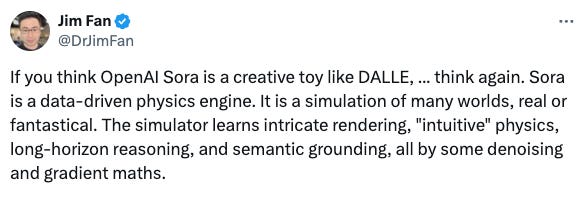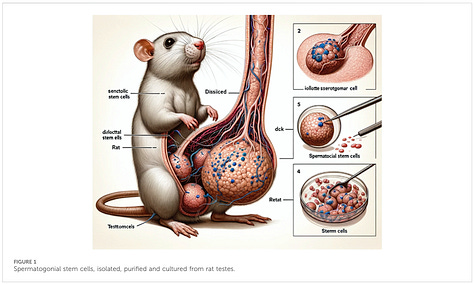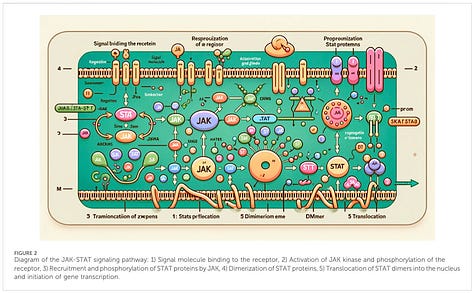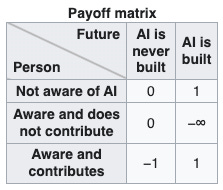OpenAI — Sora Marks the Great Divide
Video generative AI to spark industry shake-ups. With looming ethical concerns, copyright challenges, and SAG-AFTRA’s defense of performer rights amid the artificial content creation surge.
Read to the end to see how a respected scientific journal faced public scrutiny and retraction of a peer-reviewed article due to AI-generated images.
We are on the precipice of a new frontier where the boundary between reality and fabrication blurs. In this moment, the limitations of our perception become glaringly apparent as the naked eye—already an unreliable witness—struggles to distinguish the real from the artificial. This phenomenon is not a pure novelty but a harbinger of the changes that technologies like Sora, a diffusion text-to-video model developed by OpenAI, promise to bring to our world.
Source: OpenAI video and prompt
The specter of Roko’s basilisk looms as a reminder of the unpredictable paths that AI development may take, stressing the need for a cautious and ethical approach to research that prioritizes the welfare of humanity above all.1
Evolution in AI Video Creation
Sora represents the cutting edge of generative AI, capable of producing videos from text instructions. It transcends the capabilities of its predecessors, creating not just images but entire narratives that unfold over time. This leap forward muddies the lines between creator and creation, offering a glimpse into a future where what we imagine can be brought to life with unprecedented ease and fidelity.

While Sora signifies a leap forward in generative AI with 60-second video creation, it joins a landscape teeming with innovation from companies dedicated to video-based AI applications.2 Notably, Runway ML offers tools that democratize complex AI operations, enabling creators to produce, edit, and experiment with 18 seconds of AI-generated videos. Similarly, companies like Synthesia and DeepBrain AI are making strides in creating realistic AI-generated videos for various applications, from automated video content creation to virtual avatars and digital humans.
The Future of Creativity
OpenAI has robust backing and widespread attention that brings this evolving technology into the spotlight, with Sora highlighting the growing potential of AI to revolutionize video production and content creation.
The presence of a dynamic competitive market sector highlights the development and transformation of how we conceive, produce, and interact with video content, paving the way for a tomorrow where AI-generated videos are indistinguishable from those produced by humans. We are a long way from such a reality.
But at this rate of progression, we may not be too far off. It is difficult not to be confronted by the ethical qualms that accompany the rise of these admirable advancements.
What are the unprecedented ethical concerns?
Refinement of hyper-realistic AI-generated content brings us face-to-face with the uncanny valley, a hypothesized psychological and aesthetic relation where entities that closely resemble humans provoke unease. As we inch closer to this threshold, the challenge extends beyond technical but also cognitive faculty, forcing us to redefine our understanding of digital authenticity in connections.
Privacy and Performer Rights in the Age of AI
In facial recognition and data collection, the ethical stakes are equally high. The power of AI to identify and analyze human faces has profound implications for privacy and autonomy. The ease with which AI can amass and process personal data calls for a rigorous examination of consent, ownership, and the right to be forgotten.3
Balancing between technological innovation and individual rights emerges as a critical arena. The advent of AI-driven video creation introduces new dynamics in film, television, and digital content empires, prompting a response from industry stakeholders, including unions like SAG-AFTRA (Screen Actors Guild‐American Federation of Television and Radio Artists).

How is AI-driven media shaping the future of the entertainment industry?
As artificial technologies become capable of generating realistic performances, SAG-AFTRA’s advocacy—an upcoming docuseries—and negotiations may evolve to address issues such as protecting performers’ digital likenesses and ensuring fair compensation and recognition for the work derived from or replicated by AI. SAG-AFTRA, representing actors, announcers, broadcast journalists, and other media professionals, faces the challenge of navigating the implications of AI on employment, copyright, and performer rights. This intersection of technology and labor rights emphasizes the need for ongoing dialogue between innovators, creators, and industry bodies to foster a future where technological advancements in entertainment respect and benefit all stakeholders involved.
OpenAI Leadership and Ethical Efforts
As CEO of OpenAI, Sam Altman’s leadership reflects a dual responsibility to push the boundaries of what machine learning can achieve while grappling with the ethical imperatives that the advancements entail. Altman’s blog reflects on entrepreneurship, innovation, and the societal shifts driven by technology.4 His insights into team building dynamics, the power of incentives, and the necessity of audacious ideas illuminate the path for OpenAI in balancing technical breakthroughs with ethical considerations by investing in full-stack safety efforts. United on a mission to stabilize and steer AI toward a beneficial outcome.
The Impact on Society and Technology
We are at the dawn of a technological epoch that marks the beginning of a transformative landscape with the emergence of Sora and similar innovations. It is not just a shift in how we interact with machines but a reimagining of the very fabric of our reality.5
The great divide unfolds between an unknown and a present teetering on the edge of obsolescence. The dialogue between innovation and ethics is the guiding star, blazing the path toward a future where technology amplifies humanity.
Engage with Artificial General Intelligence Communities
For those eager to dive into the world of AI and connect with like-minded individuals, consider joining the Discord servers for OpenAI and Runway—I’m in there, lurking. It’s a direct line to stay informed on advancements, share insights, and engage in the future of artificial general intelligence.
✚ °
> Highlight — A sphinx view of things
Our challenge is navigating the ethical, philosophical, and social dilemmas that arise with advanced AI. The current trajectory demands technological prowess and a deep commitment to the values that define us as a society.
AI Controversy in Scientific Publishing
February 16, 2024
The open-access journal Frontiers in Cell and Developmental Biology retracted a peer-reviewed article due to the pitfalls of artificial intelligence in scientific research.6 This decision came after criticism on 𝕏 for including AI-generated images that depicted anatomically incorrect mammalian testicles and sperm cells, complete with gibberish descriptions and diagrams.



These images stress the importance of maintaining rigorous editorial standards and the need for a critical evaluation of AI’s role in scientific documentation. The incident prompts a reevaluation of the reliance on technology to generate research material and the necessity for improved oversight in the peer-review process to safeguard the credibility and integrity of scientific publications.
On thinks, with inks and links
Roko’s Basilisk: A thought experiment that explores the potential for future AI to exert influence over its creation and punish those who did not help bring it into existence.
OpenAI’s white paper for Sora: Video generation models as world simulators.
Most Americans support the right to have some personal info removed from online searches, Pew Research Center
I highly recommend reading Sam Altman’s blog in reverse with the oldest post. Growth and Government: “Without economic growth, democracy doesn’t work because voters occupy a zero-sum system.”
The matrix Payoff of AI depicted resembles Pascal’s Wager.
The Frontiers retraction and the archived article.


